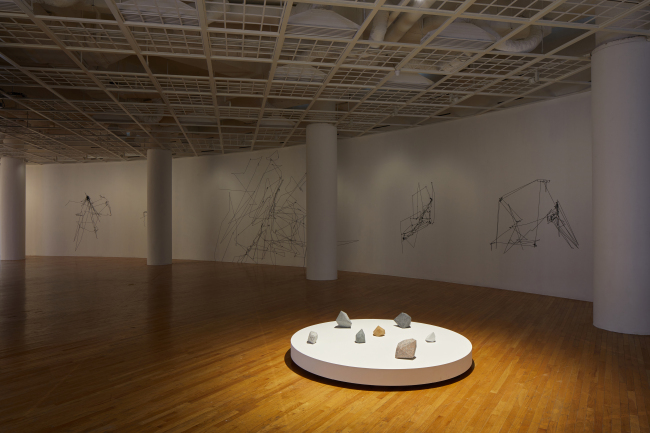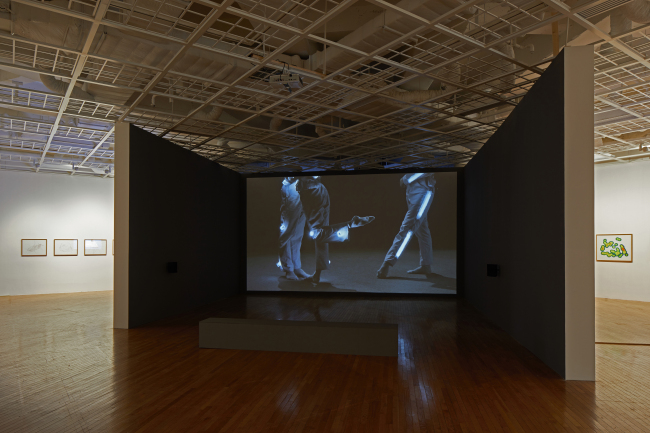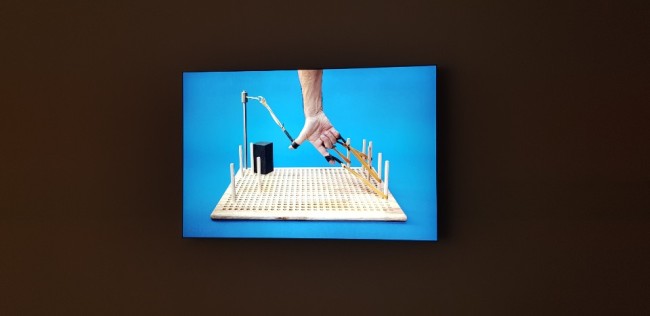[Photo News] Is this body yours or mine?
Art Sonje Center holds Julien Previeux’s first solo exhibition, ‘Pinch-to-Zoom,’ through Jan. 29
By Shim Woo-hyunPublished : Nov. 26, 2018 - 17:51
The yearslong patent battle between Samsung and Apple over the slide-to-unlock feature was perhaps one of the most explicit cases of how the human body -- human gestures, in particular -- have been privatized or incorporated into capitalism and technological development.
Julien Previeux’s first solo exhibition in South Korea comprises works that tackle phenomena in which the contemporary world “buys” the actions of human bodies.
Julien Previeux’s first solo exhibition in South Korea comprises works that tackle phenomena in which the contemporary world “buys” the actions of human bodies.

The exhibition starts with a 1998 video work titled “Roll,” installed outside the entrance to the exhibition. In this comically conjured five-minute video, Previeux is seen constantly rolling on the ground, from his home to other parts of the city and back home. Here and there, he throws himself against other objects and people. The artist’s friends roll alongside him as well.
“The work came from my childhood experience of watching Chris Burden, Buster Keaton, Jacques Tati and Mark Gonzales,” Previeux said during a press conference Wednesday at Art Sonje Center in Seoul. The performance is more of a mythology based on his childhood experience than on any critical theories, the artist said when asked to comment on one of his early works.
Previeux’s critical views of technology and industry surrounding body movements are more apparent in his later works, in which he analyzes specific body movements -- the ways in which technology and capitalist industry use human gestures. Then, he tweaks and reconstructs them into something free of any economic or technological functions.

Upon entering the exhibition space, the visitors see the artist’s 2018 screen work titled “What Shall We Do Next (Ultimate Pinch-to-Zoom).” Here, the artist has captured his own hand in physiotherapy equipment, performing movements emblematic of man-machine interfaces. The famous pinch-to-zoom gesture is pushed to its extreme on the physiotherapy pegboard.
The “What Shall We Do Next” series summons the latest technologies involving human movements, particularly finger gestures.
“What Shall We Do Next (Sequence #1)” is an animated video made up of patented physical gestures collected by the artist between 2007 and 2011. The video presents the animated movements of two hands, demonstrating the patented commands used to operate various electronic devices with designated patent numbers and dates in one corner.
“What Shall We Do Next? (Sequence #2),” which earned the artist the Marcel Duchamp Prize in 2014, is something of a video essay on patented movements. Here, six dancers perform, articulating the languages of those patents as if they were scores, an attempt to deprive the patented gestures of their function.

“Patterns of Life” from 2015 is yet another attempt to examine body movements and their relations to capitalist industry and technology. In this 15-minute video with narration, five dancers of the Paris Opera Ballet perform in six different settings, tracing the genealogy of the ways in which body movements have been quantified and visualized since the 19th century.
The artist often substitutes technological processes with something manual, resulting in works that are oddly poetic.
“Drawing Workshop-Police Department of the 14th District of Paris” is a set of Voronoi diagrams and heat maps that the artist asked local police officers to work on manually. These police tools, used to detect crime patterns, must be made quickly. The hand-drawn versions are useless as they take too long to complete and have now been supplanted by computer-generated versions.
In a work titled “Anthology of Gazes,” the artist uses eye movement-tracking technology -- developed for psychology research and often used by the marketing industry -- to track the eye movements of six art students from Seoul. Using threads to visualize the eye movements, the artist undermines the usage value of the technology.
Although Previeux’s critique of capitalism and technology is worthy of serious consideration, he is also artist with a sense of humor that is very much in evidence throughout his works.
By Shim Woo-hyun(ws@heraldcorp.com)











![[Today’s K-pop] BTS pop-up event to come to Seoul](http://res.heraldm.com/phpwas/restmb_idxmake.php?idx=644&simg=/content/image/2024/04/17/20240417050734_0.jpg&u=)





![[KH Explains] Hyundai's full hybrid edge to pay off amid slow transition to pure EVs](http://res.heraldm.com/phpwas/restmb_idxmake.php?idx=652&simg=/content/image/2024/04/18/20240418050645_0.jpg&u=20240418181020)

![[Today’s K-pop] Zico drops snippet of collaboration with Jennie](http://res.heraldm.com/phpwas/restmb_idxmake.php?idx=642&simg=/content/image/2024/04/18/20240418050702_0.jpg&u=)